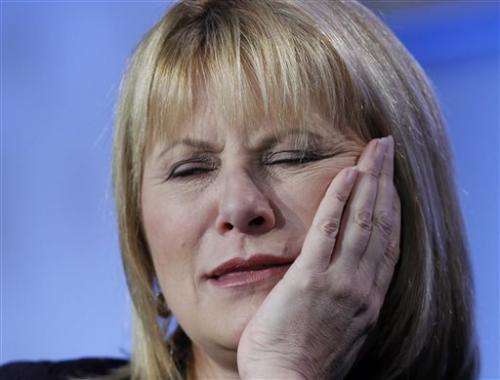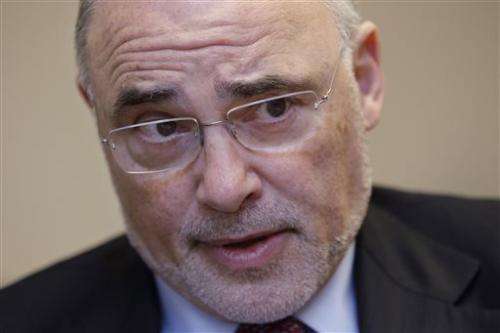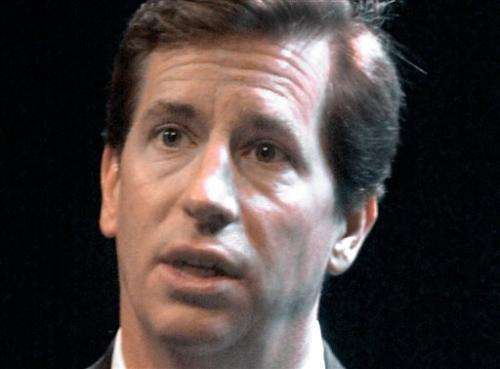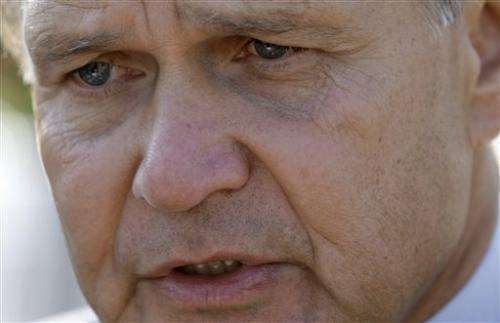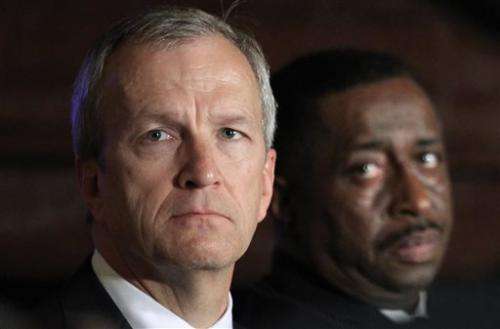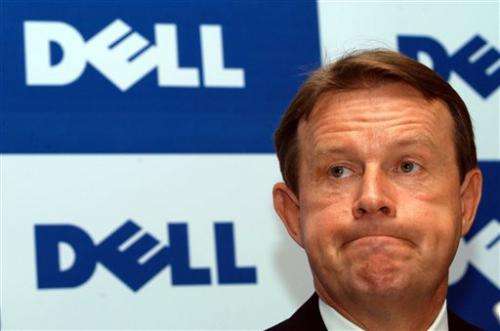In this Tuesday, Nov. 16, 2010, file photo, Yahoo CEO Carol Bartz speaks at the Web 2.0 Summit in San Francisco. The Internet company hired technology veteran Bartz in 2009, with the goal of bringing in a no-nonsense leader who would develop a clear vision. Bartz shook up Yahoo's management and instituted a cost-cutting program that helped boost the company's earnings. But revenue failed to grow even as the online ad market grew at a rapid clip. After more than 2 ½ years of financial lethargy, Yahoo fired Bartz in 2011.(AP Photo/Paul Sakuma)
Ron Johnson's short-lived tenure as J.C. Penney's CEO will go down as one of the biggest flameouts in corporate America. The former Apple executive was hailed as a big thinker when he was hired by the ailing department store chain but his radical moves ended up alienating shoppers, sent sales plunging and left the company in an even worse situation.
He lasted 17 months.
But Johnson isn't the only executive to be pushed out after failing to live up to big expectations. Here's a look at some major ousters in recent times.
CAROL BARTZ, YAHOO
The Internet company hired technology veteran Bartz in 2009, with the goal of bringing in a no-nonsense leader who would develop a clear vision. Bartz shook up Yahoo's management and instituted a cost-cutting program that helped boost the company's earnings. But revenue failed to grow even as the online ad market expanded at a rapid clip.
Bartz, known for her very direct approach and sometimes-colorful language, stressed that a turnaround would take time and pleaded for patience from shareholders, pointing out that it took Steve Jobs years to revive Apple after his return in 1997.
But after more than 2 ½ years of financial lethargy, Yahoo ousted Bartz in 2011. The company's chairman fired her over the phone, according to an email Bartz sent from her iPad that was obtained by the All Things D technology blog at the time.
LEO APOTHEKER, HEWLETT PACKARD
When HP hired Apotheker in November 2010, it was seen as an aggressive push by the company into the software business. But many analysts mocked the choice, considering that Apotheker had just been forced out of his previous job as CEO of German business software maker SAP AG following ill-timed price hikes and widespread employee dissatisfaction.
In this March 15, 2011 file photo, Hewlett Packard Company CEO Leo Apotheker, speaks during an interview in San Francisco. When HP hired Apotheker in November 2010, it was seen as an aggressive push by the company into the software business. But many analysts mocked the choice, considering Apotheker had just been forced out of his previous job as CEO of the German business software maker SAP AG following ill-timed price hikes and widespread employee dissatisfaction. After just 11 months, Apotheker was forced out and replaced by former eBay CEO Meg Whitman. (AP Photo/Paul Sakuma, file)
Apotheker was supposed to be a steady hand to steer HP out of a tumultuous time but his strategic decisions were drastic and did little to inspire confidence. He was doomed by disappointing earnings and a fumbled announcement that the company's personal computer division was for sale. Even as he struggled, Apotheker complained that HP suffered from years of under-investment by his predecessor, Mark Hurd.
Apotheker also was one of the chief backers of HP's acquisition of British software company Autonomy Corp. HP paid $10 billion for Autonomy, but later said it was deceived by improper accounting and overpaid.
After just 11 months, Apotheker was forced out and replaced by former eBay CEO Meg Whitman.
CHARLES CONAWAY, KMART
Conaway had won many fans on Wall Street as the No. 2 executive at CVS, where he helped build the drugstore chain into an industry powerhouse. When he was hired by Kmart in 2000, Conaway inherited a company with a long list of entrenched problems, including outdated technology and drab stores.
This May 15, 2001, file photo, shows Charles C. Conaway, former chief executive of Kmart Corp. Conaway had won many fans on Wall Street as the No. 2 executive at CVS, where he helped build the drugstore chain into an industry powerhouse. When he was hired as by Kmart in 2000, Conaway was inheriting a company with a long list of entrenched problems, including outdated technology and drab stores. But in early 2002, Kmart filed for Chapter 11 bankruptcy, and Conaway resigned soon after. (AP Photo/Carlos Osorio, File)
Analysts say Conaway made strategic mistakes, such as trying to compete with Wal-Mart on price and focusing on exceedingly cheap groceries rather than on its exclusive Martha Stewart brand. In early 2002, Kmart filed for Chapter 11 bankruptcy, and Conaway resigned soon after.
Conaway also faced accusations that he misled investors about Kmart's financial problems before the bankruptcy filing.
The bankruptcy led to Kmart coming under the control of Edward Lampert, a billionaire investor. Lampert later engineered the acquisition of Sears, Roebuck & Co., combining the companies into Sears Holding Corp.
BOB NARDELLI, CHRYSLER
Nardelli was hailed as an outsider who could help save the U.S. auto industry by private equity firm Cerberus Capital Management, which installed him as the head of Chrysler in August 2007. But Nardelli, who spent most of his career in the executive ranks at GE before leaving to run Home Depot, had no experience in the complex business of auto manufacturing, and it showed.
Instead of investing to improve Chrysler's substandard lineup, Nardelli focused on cutting jobs and closing plants. He alienated suppliers and dealers, who revolted when Chrysler announced plans to close dealerships and stopped financing leases. And he was gaffe-prone, at one point mistakenly telling Wisconsin's governor that an engine plant in his state would remain open.
In this Tuesday, Sept. 23, 2008, file photo, Chrysler LLC Chairman and CEO Bob Nardelli speaks with reporters in Auburn Hills, Mich. Nardelli was hailed as an outsider who could help save the U.S. auto industry by private equity firm Cerberus Capital Management, which installed him as the head of Chrysler in August 2007. But Nardelli, who spent most of his career in the executive ranks at GE before leaving to run Home Depot, had no experience in the complex business of auto manufacturing, and it showed. Instead of investing to improve Chrysler's substandard lineup, Nardelli focused on cutting jobs and closing plants. He alienated suppliers and dealers, who revolted when Chrysler announced plans to close dealerships and stopped financing leases. (AP Photo/Paul Sancya, File)
By the time the financial crisis hit in the fall of 2008, Chrysler was in serious trouble. Nardelli testified before Congress and obtained loans to help the company survive, but it was too late. Chrysler filed for bankruptcy in April 2009. When Chrysler exited bankruptcy that June, Nardelli was out and Fiat CEO Sergio Marchionne took over.
CRAIG HERKERT, SUPERVALU
The grocery store operator brought in Herkert in 2009 with the hopes that the high-ranking former Wal-Mart executive could spark a turnaround for its struggling fortunes. Supervalu, which was one of the country's biggest grocery store operators at the time, was struggling with growing competition at big-box retailers, drugstores and dollar stores.
In this Wednesday, July 20, 2011, file photo, Supervalu Chief Executive Officer Craig Herkert, left, and Greg Calhoun, founder and CEO of Calhoun Enterprises, attend a White House event hosted by first lady Michelle Obama in Washington. The grocery store operator brought in Herkert in 2009 with the hopes that the high-ranking former Wal-Mart executive could spark a turnaround for its struggling fortunes. Under his tenure, Herkert tried positioning Supervalu as a neighborhood store and emphasizing low prices. But sales and profitability kept sliding and the company suspended its dividend and announced plans to potentially put itself up for sale. A few weeks later, Herkert was out.(AP Photo/Manuel Balce Ceneta, File)
Under his tenure, Herkert tried positioning Supervalu as a neighborhood store and emphasized low prices. But sales and profitability kept sliding and last summer, the company suspended its dividend and announced plans to potentially put itself up for sale. A few weeks later, Herkert was out.
In January, the company announced that it was selling five of its major chains and focusing on its Save-A-Lot discount stores and smaller regional chains.
KEVIN ROLLINS, DELL
Rollins joined Dell in 1996 and held a variety of roles before becoming CEO in 2004, including chief operating officer, vice chairman and president of Dell Americas.
The company had been struggling with a market glut of low-cost, low-profit PCs and weaker-than-anticipated sales of its pricier, more lucrative desktops and notebooks. In 2006, it lost its No. 1 position in the industry to rival Hewlett-Packard Co.
In this Friday April 29, 2005, file photo, Kevin Rollins CEO of Dell Inc., looks on at a press conference in Bangalore, India. Rollins joined Dell in 1996 and had a variety of roles before becoming CEO in 2004, including chief operating officer, vice chairman and president of Dell Americas. But, in addition to disappointing earnings, Dell had recalled more than 4 million potentially flammable notebook batteries made by Sony Corp. in August 2006.Rollins stepped down in early 2007. Founder Michael Dell took the CEO job back.(AP Photo/Gautam Singh)
In addition to disappointing earnings, Dell had recalled more than 4 million potentially flammable notebook batteries made by Sony Corp. in August 2006. The company's accounting practices had come under federal scrutiny as well.
The key parallel between Rollins and Penney's Johnson may have been overpromising. Rollins took the reins of a company doing a little more than $40 billion a year in business and painted pictures of bumping that to $80 billion—which Dell has still not approached.
Rollins stepped down in early 2007. Founder Michael Dell took the CEO job back.
Copyright 2013 The Associated Press. All rights reserved. This material may not be published, broadcast, rewritten or redistributed.
